Agilent 1260 Infinity DAD and MWD User Manual 101
How to optimize the Detector
5
Optimization Overview
Optimization Overview
Tabl e 1 5 Optimization Overview
Parameter Impact
1 Selection of flow cell • peak resolution versus sensitivity
• Choose flow cell according to used column, see Figure 32 on page 102.
2 Connection of flow cell • chromatographic resolution
• For flow rates from 0.5 mL/min connect column using the
zero-dead-volume fittings of the detector.
• For small column i.d. (e.g 1 mm) the inlet capillary of the micro flow cell
can be connected directly to the column.
3 Setting the peak width (response time) • peak resolution versus sensitivity
versus disk space
• Use peak width according Figure 32 on page 102 as starting point.
• Set the peak-width close to the width of a narrow peak of interest in your
chromatogram.
4 Setting wavelength and bandwidth
• Sample wavelength:
• Never miss a peak by the use of a browser wavelength like 250 nm
with 100 nm bandwidth.
• Select specific wavelength with reduced bandwidth if you need
selectivity, e.g. 250,10 nm and 360,100 nm as reference wavelength.
• Set the sample wavelength to a peak or valley in the spectrum to get
best linearity for high concentrations.
• sensitivity versus selectivity
• sensitivity versus linearity
• Reference wavelength:
• Select the reference wavelength with broad bandwidth (30...100 nm)
wavelength range where your analytes have little or no absorbance
(e.g. sample at 254 nm, reference at 320 nm).
• baseline drift due to RI effects.

